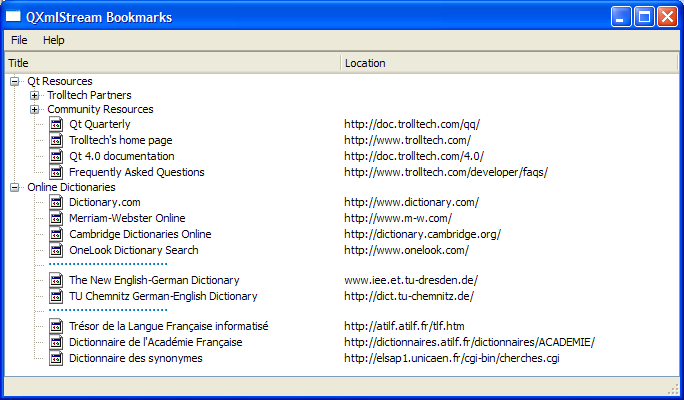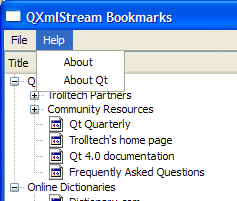QXmlStream Bookmarks Example¶
Demonstrates how to read and write to XBEL files.
The QXmlStream Bookmarks example provides a reader for XML Bookmark Exchange Language (XBEL) files using Qt’s
QXmlStreamReaderclass for reading, andQXmlStreamWriterclass for writing the files.
XbelWriter Class Definition¶
The
XbelWriterclass contains a private instance ofQXmlStreamWriter, which provides an XML writer with a streaming API.XbelWriteralso has a reference to theQTreeWidgetinstance where the bookmark hierarchy is stored.class XbelWriter { public: explicit XbelWriter(const QTreeWidget *treeWidget); bool writeFile(QIODevice *device); private: void writeItem(const QTreeWidgetItem *item); QXmlStreamWriter xml; const QTreeWidget *treeWidget; };
XbelWriter Class Implementation¶
The
XbelWriterconstructor accepts atreeWidgetto initialize within its definition. We enableQXmlStreamWriter‘s auto-formatting property to ensure line-breaks and indentations are added automatically to empty sections between elements, increasing readability as the data is split into several lines.XbelWriter::XbelWriter(const QTreeWidget *treeWidget) : treeWidget(treeWidget) { xml.setAutoFormatting(true); }The
writeFile()function accepts aQIODeviceobject and sets it usingsetDevice(). This function then writes the document type definition(DTD), the start element, the version, andtreeWidget‘s top-level items.bool XbelWriter::writeFile(QIODevice *device) { xml.setDevice(device); xml.writeStartDocument(); xml.writeDTD(QStringLiteral("<!DOCTYPE xbel>")); xml.writeStartElement(QStringLiteral("xbel")); xml.writeAttribute(XbelReader::versionAttribute(), QStringLiteral("1.0")); for (int i = 0; i < treeWidget->topLevelItemCount(); ++i) writeItem(treeWidget->topLevelItem(i)); xml.writeEndDocument(); return true; }The
writeItem()function accepts aQTreeWidgetItemobject and writes it to the stream, depending on itstagName, which can either be a “folder”, “bookmark”, or “separator”.void XbelWriter::writeItem(const QTreeWidgetItem *item) { QString tagName = item->data(0, Qt::UserRole).toString(); if (tagName == QLatin1String("folder")) { bool folded = !item->isExpanded(); xml.writeStartElement(tagName); xml.writeAttribute(XbelReader::foldedAttribute(), folded ? yesValue() : noValue()); xml.writeTextElement(titleElement(), item->text(0)); for (int i = 0; i < item->childCount(); ++i) writeItem(item->child(i)); xml.writeEndElement(); } else if (tagName == QLatin1String("bookmark")) { xml.writeStartElement(tagName); if (!item->text(1).isEmpty()) xml.writeAttribute(XbelReader::hrefAttribute(), item->text(1)); xml.writeTextElement(titleElement(), item->text(0)); xml.writeEndElement(); } else if (tagName == QLatin1String("separator")) { xml.writeEmptyElement(tagName); } }
XbelReader Class Definition¶
The
XbelReadercontains a private instance ofQXmlStreamReader, the companion class toQXmlStreamWriter.XbelReaderalso contains a reference to theQTreeWidgetthat is used to group the bookmarks according to their hierarchy.class XbelReader { public: XbelReader(QTreeWidget *treeWidget); bool read(QIODevice *device); QString errorString() const; static inline QString versionAttribute() { return QStringLiteral("version"); } static inline QString hrefAttribute() { return QStringLiteral("href"); } static inline QString foldedAttribute() { return QStringLiteral("folded"); } private: void readXBEL(); void readTitle(QTreeWidgetItem *item); void readSeparator(QTreeWidgetItem *item); void readFolder(QTreeWidgetItem *item); void readBookmark(QTreeWidgetItem *item); QTreeWidgetItem *createChildItem(QTreeWidgetItem *item); QXmlStreamReader xml; QTreeWidget *treeWidget; QIcon folderIcon; QIcon bookmarkIcon; };
XbelReader Class Implementation¶
The
XbelReaderconstructor accepts aQTreeWidgetto initialize thetreeWidgetwithin its definition. AQStyleobject is used to settreeWidget‘s style property. ThefolderIconis set toNormalmode where the pixmap is only displayed when the user is not interacting with the icon. TheSP_DirClosedIcon,SP_DirOpenIcon, andSP_FileIconcorrespond to standard pixmaps that follow the style of your GUI.XbelReader::XbelReader(QTreeWidget *treeWidget) : treeWidget(treeWidget) { QStyle *style = treeWidget->style(); folderIcon.addPixmap(style->standardPixmap(QStyle::SP_DirClosedIcon), QIcon::Normal, QIcon::Off); folderIcon.addPixmap(style->standardPixmap(QStyle::SP_DirOpenIcon), QIcon::Normal, QIcon::On); bookmarkIcon.addPixmap(style->standardPixmap(QStyle::SP_FileIcon)); }The
read()function accepts aQIODeviceand sets it usingsetDevice(). The actual process of reading only takes place if the file is a valid XBEL 1.0 file. Note that the XML input needs to be well-formed to be accepted byQXmlStreamReader. Otherwise, theraiseError()function is used to display an error message. Since the XBEL reader is only concerned with reading XML elements, it makes extensive use of thereadNextStartElement()convenience function.bool XbelReader::read(QIODevice *device) { xml.setDevice(device); if (xml.readNextStartElement()) { if (xml.name() == QLatin1String("xbel") && xml.attributes().value(versionAttribute()) == QLatin1String("1.0")) { readXBEL(); } else { xml.raiseError(QObject::tr("The file is not an XBEL version 1.0 file.")); } } return !xml.error(); }The
errorString()function is used if an error occurred, in order to obtain a description of the error complete with line and column number information.QString XbelReader::errorString() const { return QObject::tr("%1\nLine %2, column %3") .arg(xml.errorString()) .arg(xml.lineNumber()) .arg(xml.columnNumber()); }The
readXBEL()function reads the name of a startElement and calls the appropriate function to read it, depending on whether if its a “folder”, “bookmark” or “separator”. Otherwise, it callsskipCurrentElement(). TheQ_ASSERT()macro is used to provide a pre-condition for the function.void XbelReader::readXBEL() { Q_ASSERT(xml.isStartElement() && xml.name() == QLatin1String("xbel")); while (xml.readNextStartElement()) { if (xml.name() == QLatin1String("folder")) readFolder(0); else if (xml.name() == QLatin1String("bookmark")) readBookmark(0); else if (xml.name() == QLatin1String("separator")) readSeparator(0); else xml.skipCurrentElement(); } }The
readTitle()function reads the bookmark’s title.void XbelReader::readTitle(QTreeWidgetItem *item) { Q_ASSERT(xml.isStartElement() && xml.name() == QLatin1String("title")); QString title = xml.readElementText(); item->setText(0, title); }The
readSeparator()function creates a separator and sets its flags. The text is set to 30 “0xB7”, the HEX equivalent for period. The element is then skipped usingskipCurrentElement().void XbelReader::readSeparator(QTreeWidgetItem *item) { Q_ASSERT(xml.isStartElement() && xml.name() == QLatin1String("separator")); QTreeWidgetItem *separator = createChildItem(item); separator->setFlags(item->flags() & ~Qt::ItemIsSelectable); separator->setText(0, QString(30, 0xB7)); xml.skipCurrentElement(); }
MainWindow Class Definition¶
The
MainWindowclass is a subclass ofQMainWindow, with aFilemenu and aHelpmenu.class MainWindow : public QMainWindow { Q_OBJECT public: MainWindow(); public slots: void open(); void saveAs(); void about(); #if !defined(QT_NO_CONTEXTMENU) && !defined(QT_NO_CLIPBOARD) void onCustomContextMenuRequested(const QPoint &pos); #endif private: void createMenus(); QTreeWidget *treeWidget; };
MainWindow Class Implementation¶
The
MainWindowconstructor instantiates theQTreeWidgetobject,treeWidgetand sets its header with aQStringListobject,labels. The constructor also invokescreateActions()andcreateMenus()to set up the menus and their corresponding actions. ThestatusBar()is used to display the message “Ready” and the window’s size is fixed to 480x320 pixels.MainWindow::MainWindow() { QStringList labels; labels << tr("Title") << tr("Location"); treeWidget = new QTreeWidget; treeWidget->header()->setSectionResizeMode(QHeaderView::Stretch); treeWidget->setHeaderLabels(labels); #if !defined(QT_NO_CONTEXTMENU) && !defined(QT_NO_CLIPBOARD) treeWidget->setContextMenuPolicy(Qt::CustomContextMenu); connect(treeWidget, &QWidget::customContextMenuRequested, this, &MainWindow::onCustomContextMenuRequested); #endif setCentralWidget(treeWidget); createMenus(); statusBar()->showMessage(tr("Ready")); setWindowTitle(tr("QXmlStream Bookmarks")); const QSize availableSize = screen()->availableGeometry().size(); resize(availableSize.width() / 2, availableSize.height() / 3); }The
open()function enables the user to open an XBEL file usinggetOpenFileName(). A warning message is displayed along with thefileNameanderrorStringif the file cannot be read or if there is a parse error.void MainWindow::open() { QString fileName = QFileDialog::getOpenFileName(this, tr("Open Bookmark File"), QDir::currentPath(), tr("XBEL Files (*.xbel *.xml)")); if (fileName.isEmpty()) return; treeWidget->clear(); QFile file(fileName); if (!file.open(QFile::ReadOnly | QFile::Text)) { QMessageBox::warning(this, tr("QXmlStream Bookmarks"), tr("Cannot read file %1:\n%2.") .arg(QDir::toNativeSeparators(fileName), file.errorString())); return; } XbelReader reader(treeWidget); if (!reader.read(&file)) { QMessageBox::warning(this, tr("QXmlStream Bookmarks"), tr("Parse error in file %1:\n\n%2") .arg(QDir::toNativeSeparators(fileName), reader.errorString())); } else { statusBar()->showMessage(tr("File loaded"), 2000); } }The
saveAs()function displays aQFileDialog, prompting the user for afileNameusinggetSaveFileName(). Similar to theopen()function, this function also displays a warning message if the file cannot be written to.void MainWindow::saveAs() { QString fileName = QFileDialog::getSaveFileName(this, tr("Save Bookmark File"), QDir::currentPath(), tr("XBEL Files (*.xbel *.xml)")); if (fileName.isEmpty()) return; QFile file(fileName); if (!file.open(QFile::WriteOnly | QFile::Text)) { QMessageBox::warning(this, tr("QXmlStream Bookmarks"), tr("Cannot write file %1:\n%2.") .arg(QDir::toNativeSeparators(fileName), file.errorString())); return; } XbelWriter writer(treeWidget); if (writer.writeFile(&file)) statusBar()->showMessage(tr("File saved"), 2000); }The
about()function displays aQMessageBoxwith a brief description of the example.void MainWindow::about() { QMessageBox::about(this, tr("About QXmlStream Bookmarks"), tr("The <b>QXmlStream Bookmarks</b> example demonstrates how to use Qt's " "QXmlStream classes to read and write XML documents.")); }In order to implement the
open(),saveAs(),exit(),about()andaboutQt()functions, we connect them toQActionobjects and add them to thefileMenuandhelpMenu. The connections are as shown below:void MainWindow::createMenus() { QMenu *fileMenu = menuBar()->addMenu(tr("&File")); QAction *openAct = fileMenu->addAction(tr("&Open..."), this, &MainWindow::open); openAct->setShortcuts(QKeySequence::Open); QAction *saveAsAct = fileMenu->addAction(tr("&Save As..."), this, &MainWindow::saveAs); saveAsAct->setShortcuts(QKeySequence::SaveAs); QAction *exitAct = fileMenu->addAction(tr("E&xit"), this, &QWidget::close); exitAct->setShortcuts(QKeySequence::Quit); menuBar()->addSeparator(); QMenu *helpMenu = menuBar()->addMenu(tr("&Help")); helpMenu->addAction(tr("&About"), this, &MainWindow::about); helpMenu->addAction(tr("About &Qt"), qApp, &QCoreApplication::quit); }The
createMenus()function creates thefileMenuandhelpMenuand adds theQActionobjects to them in order to create the menu shown in the screenshot below:
void MainWindow::createMenus() { QMenu *fileMenu = menuBar()->addMenu(tr("&File")); QAction *openAct = fileMenu->addAction(tr("&Open..."), this, &MainWindow::open); openAct->setShortcuts(QKeySequence::Open); QAction *saveAsAct = fileMenu->addAction(tr("&Save As..."), this, &MainWindow::saveAs); saveAsAct->setShortcuts(QKeySequence::SaveAs); QAction *exitAct = fileMenu->addAction(tr("E&xit"), this, &QWidget::close); exitAct->setShortcuts(QKeySequence::Quit); menuBar()->addSeparator(); QMenu *helpMenu = menuBar()->addMenu(tr("&Help")); helpMenu->addAction(tr("&About"), this, &MainWindow::about); helpMenu->addAction(tr("About &Qt"), qApp, &QCoreApplication::quit); }
main()
Function¶
The
main()function instantiatesMainWindowand invokes theshow()function.int main(int argc, char *argv[]) { QApplication app(argc, argv); MainWindow mainWin; mainWin.show(); mainWin.open(); return app.exec(); }See the XML Bookmark Exchange Language Resource Page for more information about XBEL files.
© 2022 The Qt Company Ltd. Documentation contributions included herein are the copyrights of their respective owners. The documentation provided herein is licensed under the terms of the GNU Free Documentation License version 1.3 as published by the Free Software Foundation. Qt and respective logos are trademarks of The Qt Company Ltd. in Finland and/or other countries worldwide. All other trademarks are property of their respective owners.


